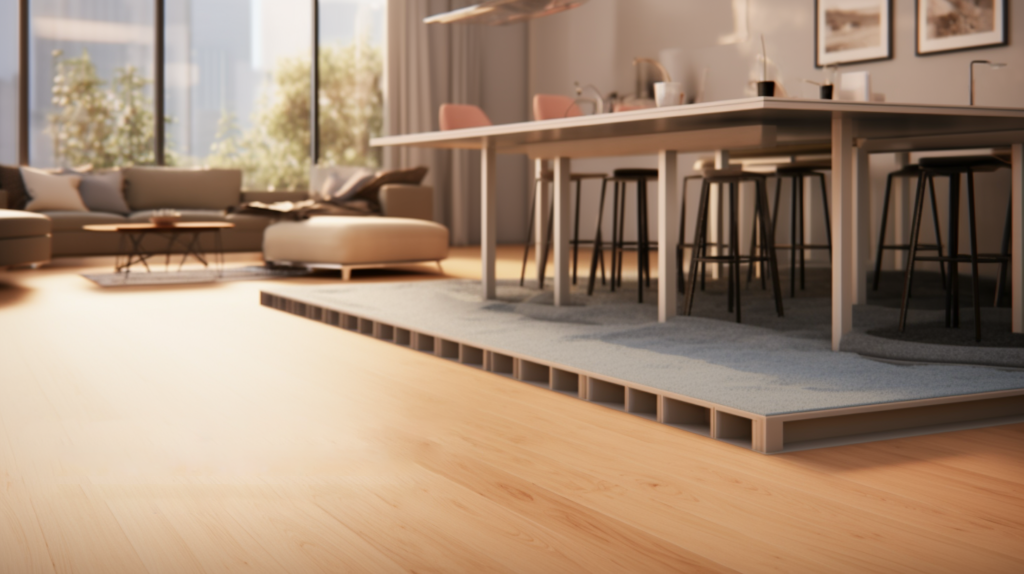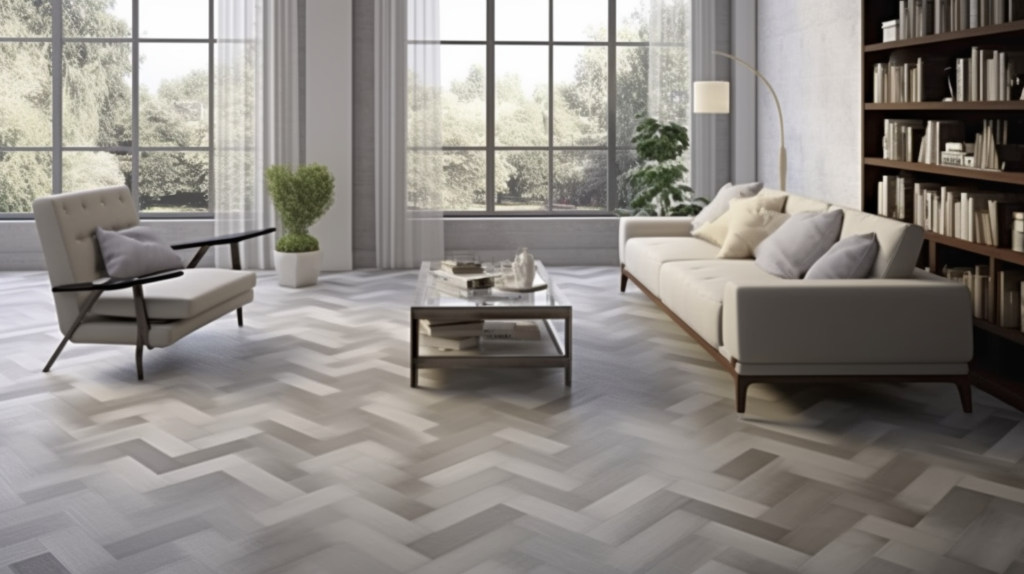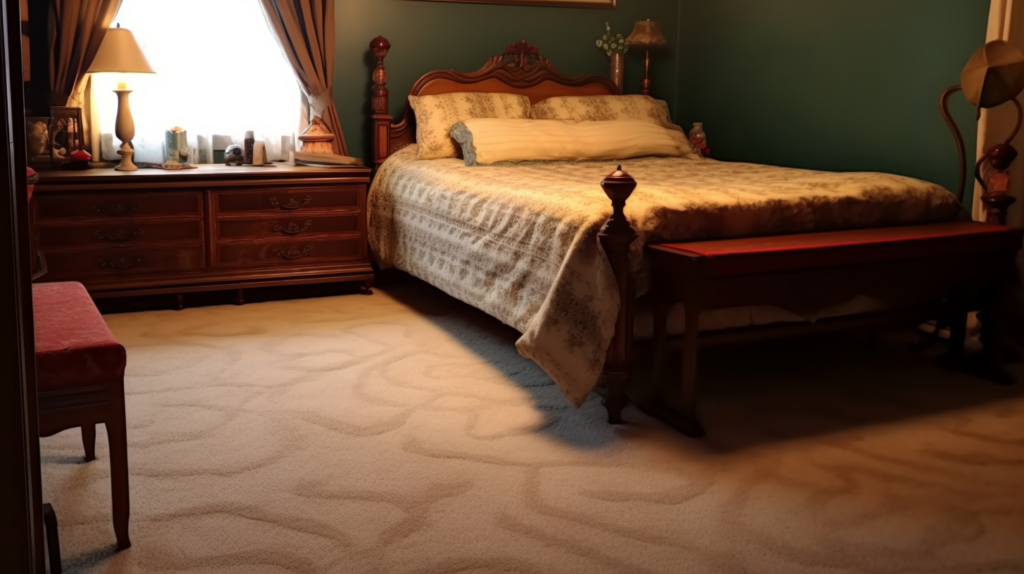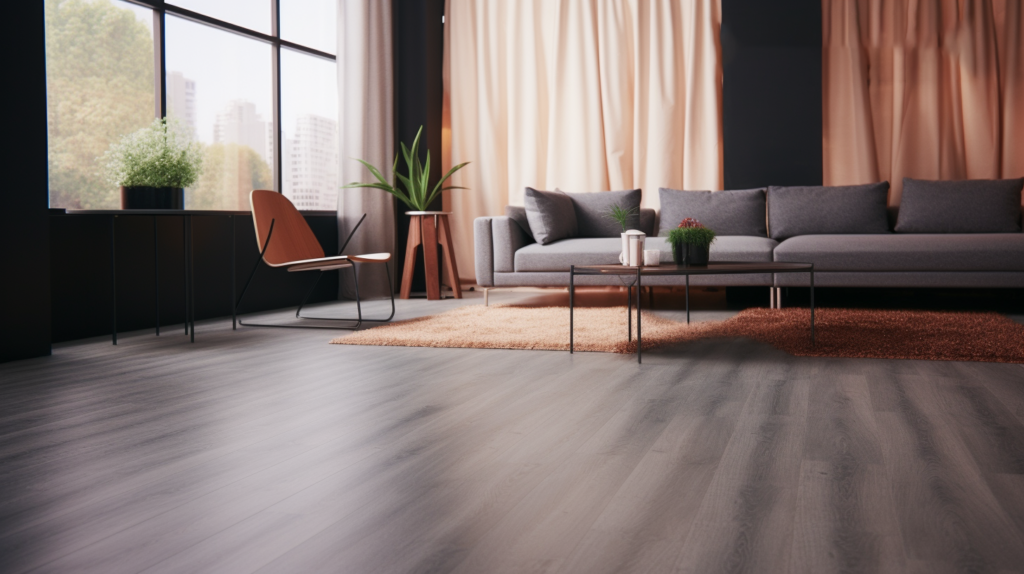Is your home filled with excessive noise that drives you crazy?
The most effective soundproof flooring uses double layers to block noise transfer. But foam underlay upgrades also dampen noise at lower cost.
Let’s dive into ranking flooring for noise reduction to find your best fit.
Types of Flooring for Soundproofing

When it comes to soundproofing a room, the flooring can make a major difference in how much noise passes through.
There are several flooring options specifically designed to reduce noise transfer and dampen sound.
In this article, we will overview the main types of flooring to consider for sound insulation and rank them by effectiveness.
1. Double Layer Flooring

Double layer flooring involves installing two layers of flooring with a decoupling layer in between. This air gap acts as a buffer that dampens noise and blocks transfer of vibrations.
Double layer systems are the most effective option for soundproofing floors, capable of reducing noise by 25 decibels or more.
There are a few different ways to create a double layer floor. One method is to install a floating subfloor over the existing floor, using foam or cork underlayment.
Next, your choice of floor covering like laminate or engineered wood goes on top. The underlayment dampens noise while the two layers prevent noise transfer.
Another approach is to use staggered studs underneath, creating separation between the subfloor and joists. Batt insulation placed in the stud bays adds mass and absorption.
Some double layer systems come with specialized acoustic clips or channels to decouple the two floors. These enhance noise blocking by preventing transfer of vibrations.
Overall, double layer flooring blocks airborne and impact sound transmission better than any other option.
With the right materials and proper installation, noise reduction can exceed 25 decibels.
This level of soundproofing performance makes double layer systems ideal for multifamily housing, basements, home theaters and more.
2. Laminate/Vinyl with Foam Underlayment

Laminate and vinyl flooring already provide some noise insulation on their own.
But adding a high-quality foam underlayment takes the sound dampening to the next level. With underlayment, these flooring types can reduce airborne noise by 18-25 decibels.
The underlayment is the key element providing noise blocking. Look for acoustic foam options made from recycled rubber, cork or Virgin SBR formulations.
The density rating indicates sound dampening capability – the higher the number, the better. Some premium underlayments have both noise blocking and anti-vibration features.
On top of the underlayment goes your laminate or vinyl planks. Either option gives a further noise barrier thanks to the floors’ rigid construction.
Laminate utilizes fused layers while vinyl has a resilient core. Combined with foam underlay, walking noise and other impact sound transfer is significantly decreased.
Laminate or vinyl flooring takes well to foam underpadding. Installation is simple compared to other soundproofing floors, making DIY friendly.
As long as the correct underlay thickness and density is used, noise reduction of 18-25 decibels can be achieved. This matches insulation levels of far pricier flooring but at a more budget-friendly cost.
3. Rubber Flooring

Known for its durability, rubber flooring has excellent noise dampening abilities as well. By nature, rubber blocks and absorbs noise rather than transferring vibrations.
As a result, rubber floors reduce airborne and impact noise by 14-21 decibels on average.
There are a few types of rubber flooring to consider. Rolled rubber sheeting provides seamless coverage, often used for basement subfloors.
Interlocking rubber tiles allow flexible installation patterns. These are commonly seen in gyms and fitness centers. Finally, poured rubber floors offer heavy-duty acoustic insulation.
In all rubber flooring, density and thickness play a role in sound dampening. Commercial rubber floors tend to be thicker and denser, with the capacity to reduce noise up to 21 decibels.
Home rubber tiles are thinner but still provide decent sound insulation around 14 decibels.
Rubber’s natural dampening properties give it an advantage over other hard surfaces. As footsteps and other impact noise hit the floor, the rubber absorbs vibrations rather than passing them on.
This prevents echoing and transmission to lower levels. Rubber flooring works equally well against airborne noise like voices.
Overall an effective solution for multi-level and commercial buildings that demand acoustic control.
4. Cork Flooring

Known for its eco-friendly profile, cork flooring offers moderate soundproofing as a bonus feature. Cork naturally absorbs and blocks noise due to its honeycomb cellular structure.
Quiet Walk cork floors reduce both airborne and impact sound transmission by 13-15 decibels on average.
The resilient honeycomb construction gives cork both absorption and barrier properties. Noise enters the tiny air pockets, dissipating the vibrations so less gets transmitted.
Cork also forms a barrier preventing noise transfer to the subfloor. Combine these qualities and walking, voices, appliances and other impact noise are noticeably reduced.
Cork flooring comes in both tile and plank formats to fit various project needs. Tiles offer flexible installation patterns, working well for entryways, laundry rooms and basements.
Floating cork planks better suit living spaces like bedrooms and dining rooms. For improved acoustic control, opt for thicker profile tiles or planks wherever possible.
While not the most heavy-duty soundproof option, cork floors notably dampen noise in their own right.
This makes them suitable for condos, apartments and multi-level homes where noise transfer issues are moderate.
Eco-minded homeowners often choose cork specifically for environmental reasons while benefiting from built-in sound insulation.
5. Carpet

Carpet has long been valued for its ability to soften impact noise and reduce echos. Heavy foot traffic, moving furniture and even rambunctious kids make less noise on carpeted floors.
While carpet may not achieve the highest noise reduction levels, it still effectively absorbs impact and airborne sound.
The key to carpet’s noise dampening abilities lies in the fibers and padding underneath. Fibers vary in thickness and density, fine delicate strands versus tight low pile types.
Thicker shag carpets works best for absorbing noises reflected across hard surfaces. The dense cushioning under carpets also dampens impact noise from footsteps and dropped objects.
Overall carpeting reduces airborne noise like speech and television sound by 10-20 decibels. For impact noise such as footsteps, noise reduction ranges 15-25 decibels.
Wool and nylon carpets rate on the higher end thanks to more sound dampening mass.ngram level loop pile carpets offer a budget floor noise solution, still lowering decibel levels 10-15 range on average.
In spaces prone to echoing noise like hallways or tiled kitchens, a simple rug can soak up excessive sound.
Area and wall to wall carpeting helps contain noise between rooms with doors closed.
While carpeting may not match rubber and double layers overall, it conveniently reduces floor noise across many living spaces.
How Do The Different Flooring Rank by Soundproofing Effectiveness?

After covering the main types of flooring with noise dampening capacities, how do they compare for overall soundproofing? Here we rank the options from most to least effective based on decibel reduction levels.
1. Double Layer Flooring
Taking the top spot for maximum noise blocking are double layer floor systems with 25+ decibel reduction on average.
Creating separation between subfloor and floor covering provides isolation of impact and airborne sound.
Pairing the air gap or staggered studs with absorptive insulation optimizes acoustic control results.
While double layer flooring carries the highest material and installation costs, nothing beats it for effectiveness.
In old buildings with minimal insulation or noisy mixed-use spaces, double layer floors make sense despite the investment.
They also provide value insulation against both airborne and impact noise compared with other targeted options.
2. Laminate/Vinyl with Foam Underlayment
A budget-friendly route to serious sound dampening, laminate or vinyl paired foam underlay provides noise reduction between 18-25 decibels.
This impressive range matches premium floors, with the simple addition of quality underpadding doing most of the work.
Acoustic foam stops noise transmission underneath while the laminate/vinyl layer provides mass.
Foam underlayment takes care of both airborne and impact noise at affordable cost. Homeowners benefit from laminate or vinyl visual appeal and durability as well.
As a straightforward upgrade over slab or subfloor, noise insulating foam padding gives top value. It also suits various spaces from home theaters to laundry rooms with ease.
3. Rubber Flooring
Valued for durability and cushioning, rubber floors have inherent noise dampening in their chemical makeup.
By absorbing vibrations rather than transferring them, rubber blocks noise 14-21 decibels based on thickness.
Commercial rubber flooring formats like rolled sheeting gets maxim effectiveness thanks to extra mass. But even thinner home rubber tiles make a noticeable difference in reducing noise.
Rubber tackles both impact and airborne sound, making it versatile for echoey spaces and home gyms. Interlocking rubber tiles prove DIY friendly for basement and laundry installs.
As a chemical-free abatement option, rubber flooring offers healthy sound insulation. The durability and antimicrobial properties serve commercial spaces well over long term use too.
4. Cork Flooring
With its signature honeycomb look, cork flooring offers respectable noise reduction abilities between 13-15 decibels.
The natural cellular structure absorbs errant vibrations and blocks excess noise transfer. Cork rates as an eco-friendly choice for modest sound dampening needs.
While not the strongest contender for significantly noisy spaces, cork helps diminish general impact and airborne sounds.
Footsteps, voices and other living noises are less bothersome over cork floors. Easy to install tiles or planks work for various rooms where style matters along with a little noise control.
Cork regularly appeals to green builders and homeowners for its sustainable profile with acoustic benefits a secondary perk.
5. Carpet
Lastly, carpeting over subfloor reduces excess noise 10-20 decibels through fibers and cushioning effects.
The dense fibers absorb echoing airborne sound while the padding minimizes impact noise textures.
From a value perspective, carpeting effectively decreases noise chatting, footsteps and other common living disruption.
While carpeting cannot match rubber and double layer engineering, its convenient sound dampening suits many households well.
Containing noise between rooms and softening hard floor transmission are regular bonuses. Rugs provide special control overtop other floors where noises concentrate in traffic zones or echoes arise.
Thanks to roll out convenience and remodeling familiarity, carpets maintain go-to status for their built-in noise insulation attributes.
Conclusion
When evaluating options for soundproofing floor spaces, double layer systems top out with maximum noise blocking capacity.
For cost-effective yet high performance dampening, laminate or vinyl paired with foam underlay comes closest in the mid-range.
Rubber, cork and standard carpeting provide more modest yet reliable sound insulation worth factoring depending noise conditions.
Determining space usage, noise sources and budget ultimately helps dictate suitable acoustic flooring.
In severe multi-family noise conflicts or demanding commercial spaces, investing in custom double layer flooring makes sense long term.
For renovating general living zones on middle ground budgets, upgraded foam underlay merits consideration too.
Even basic rubber mats, cork or carpeting assist in notably reducing excess noise disruption for peace of mind.
Hopefully reviewing the types of flooring materials capable of sound dampening gives helpful perspective.
When selecting new floors or upgrading existing, check on acoustic ratings to identify options that fit needs.
An intentional approach allows leveraging floor installations for preventative noise control along the way.
Investing a little extra in sound-absorbing floors saves amendment hassles down the road while enhancing interior comfort.
